-
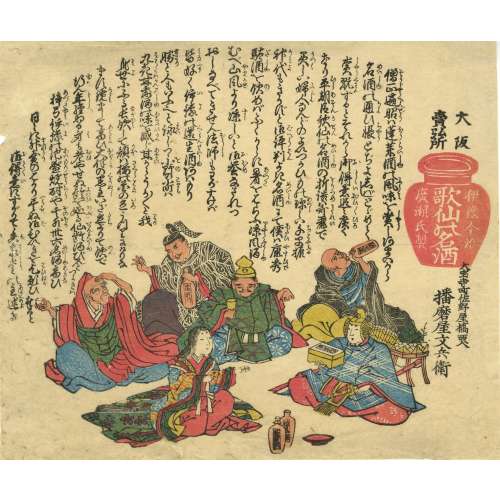 An uncut fan print uchiwa-e, size 22.7 x 28.7cm, by an unknown artist.
An uncut fan print uchiwa-e, size 22.7 x 28.7cm, by an unknown artist. -
 Artist: Utagawa Sadahide [歌川 貞秀], a.k.a. Gountei Sadahide [五雲亭 貞秀] (1807 – c. 1878/9). Signed: Gountei Sadahide ga [五雲亭貞秀画] Pubisher: Ibaya Senzaburō [伊場屋仙三郎] (Japanese, 1815 – 1869) Date-aratame seal: Bunsei 13 / Tenpō 1 (1830). Ref: Ritsumeikan University # Z0172-587. Title: The tatami night robe of Iwao [巌の畳夜着] (Kyusue Iwao no tatami yogi); 灸すゑ巌の畳夜着(きゅうすえいわおのたたみよぎ。「灸すえ」– one of the main melodies in katōbushi (河東節) type of jōruri [浄瑠璃]. For a detailed explanation in Japanese, see also HERE). The night robe of Iwao is decorated with characters resembling Arabic numerals, and Latin and Cyrillic letters. A similar kimono can be seen on Kunisada's print Hotoke Gozen, Mirror of Virtuous and Wise Women (Kenjo Kagami) at RISD museum accession number 13.1383, portraying Hotoke Gozen (佛御前), a character of The Tale of the Heike [平家物語] (Heike Monogatari); published by Yamamotoya Heikichi (山本屋平吉) (Japanese, fl. c. 1812 – 1886) in the 1830s (see below).A series of three prints is dedicated to a katōbushi performance of the Soga-themed plays.
Artist: Utagawa Sadahide [歌川 貞秀], a.k.a. Gountei Sadahide [五雲亭 貞秀] (1807 – c. 1878/9). Signed: Gountei Sadahide ga [五雲亭貞秀画] Pubisher: Ibaya Senzaburō [伊場屋仙三郎] (Japanese, 1815 – 1869) Date-aratame seal: Bunsei 13 / Tenpō 1 (1830). Ref: Ritsumeikan University # Z0172-587. Title: The tatami night robe of Iwao [巌の畳夜着] (Kyusue Iwao no tatami yogi); 灸すゑ巌の畳夜着(きゅうすえいわおのたたみよぎ。「灸すえ」– one of the main melodies in katōbushi (河東節) type of jōruri [浄瑠璃]. For a detailed explanation in Japanese, see also HERE). The night robe of Iwao is decorated with characters resembling Arabic numerals, and Latin and Cyrillic letters. A similar kimono can be seen on Kunisada's print Hotoke Gozen, Mirror of Virtuous and Wise Women (Kenjo Kagami) at RISD museum accession number 13.1383, portraying Hotoke Gozen (佛御前), a character of The Tale of the Heike [平家物語] (Heike Monogatari); published by Yamamotoya Heikichi (山本屋平吉) (Japanese, fl. c. 1812 – 1886) in the 1830s (see below).A series of three prints is dedicated to a katōbushi performance of the Soga-themed plays.
RISDM 13-1383
They all have a background of hail patterns (Arare-ko-mon) [霰小紋], similar to Kunisada’s Iwai Kumesaburō II as An no Heibei [SVJP-0304.2019], see below.Yukari no Edo-zakura The tatami night robe of Iwao Tangled Hair and the Evening Braided Hat 
-
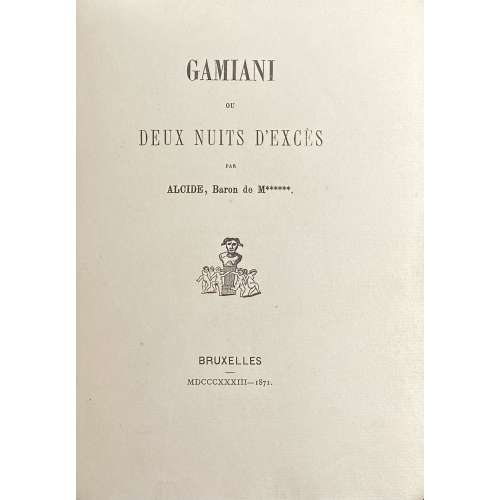 Single volume, 19.2 x 14.2 cm, bound in ¾ dark blue morocco over peacock marbled boards, gilt double-fillet border, spine with gilded raised bands, gilt fleurons and lettering, marbled endpapers, top margin gilt, outer margin uncut; text printed on watermarked laid paper; frontispiece by Félicien Rops, plates by Félix Lukkow after original lithographs by Devéria and Henri Grévedon or Octave Tassaert for the 1833 edition (1926 re-print LIB-3135.2023); the plate with the ape may be considered 'after edition of 1864' (LIB-3087.2022). Collation: π2 (h.t., t.p.) [a]8 1-712 96, total 64 leaves plus etched frontispiece in sanguine after page 8 and 12 engraved plates on India paper; illustrations include six burin engravings printed in two versions each, black and red, all six by Félix Lukkow after Devéria and Grévedon. Pagination: [4] [i] ii-viii, [1] 2-116, total 128 pages, ils. Title-page: GAMIANI | OU | DEUX NUITS D’EXCES | PAR | ALCIDE, Baron de M******. | {publisher's device} | — | BRUXELLES | MDCCCXXXIII—1871. || Limitation: Print run of 150 copies of which one unique on peau de vélin, 130 on laid paper (papier vergé), 5 on papier album jaune, 4 on papier de Chine, 10 on papier fort de Hollande. This is copy № 3, on Van Gelder laid paper, watermarked (possibly this is what they call ‘papier fort de Hollande’). Catalogue raisonné: Dutel I: A-472; Pia 520. Ref.: BNF Enfer 66. Contributors: Alfred de Musset (French, 1810 – 1857) – author. Félicien Rops (Belgian, 1833 – 1898) – artist. Félix Lukkow (French, fl. c. 1870 – 1875) – engraver. Vital Puissant (Belgian, 1835 – 1878) – publisher. Catalogue Poulet-Malassis & ses amis description: № 58. [Alfred de MUSSET - Félix LUKKOV] Alcide, baron de M******. Gamiani ou Deux nuits d’excès. Bruxelles, M DCCC XXXIII - 1871 [Vital Puissant]. In-8 de 2 .n.ch, viii, 116 pages, demi-chagrin bleu à coins, dos à nerfs orné, lets dorés et à froid sur les mors, tête dorée, tranches naturelles, non rogné (reliure de l’époque). Illustré de 7 gravures sur Chine, dont une en frontispice, en double état (sauf le frontispice) par Félix Lukkov, d’après les gravures de Félicien Rops. Tirage à 150 ex. L’un des 10 ex. tirés in-8, sur grand papier fort de Hollande (n° 3). Bibliographie : Pia 561, Per 16-14, Enfer 66, Dutel A-472.
Single volume, 19.2 x 14.2 cm, bound in ¾ dark blue morocco over peacock marbled boards, gilt double-fillet border, spine with gilded raised bands, gilt fleurons and lettering, marbled endpapers, top margin gilt, outer margin uncut; text printed on watermarked laid paper; frontispiece by Félicien Rops, plates by Félix Lukkow after original lithographs by Devéria and Henri Grévedon or Octave Tassaert for the 1833 edition (1926 re-print LIB-3135.2023); the plate with the ape may be considered 'after edition of 1864' (LIB-3087.2022). Collation: π2 (h.t., t.p.) [a]8 1-712 96, total 64 leaves plus etched frontispiece in sanguine after page 8 and 12 engraved plates on India paper; illustrations include six burin engravings printed in two versions each, black and red, all six by Félix Lukkow after Devéria and Grévedon. Pagination: [4] [i] ii-viii, [1] 2-116, total 128 pages, ils. Title-page: GAMIANI | OU | DEUX NUITS D’EXCES | PAR | ALCIDE, Baron de M******. | {publisher's device} | — | BRUXELLES | MDCCCXXXIII—1871. || Limitation: Print run of 150 copies of which one unique on peau de vélin, 130 on laid paper (papier vergé), 5 on papier album jaune, 4 on papier de Chine, 10 on papier fort de Hollande. This is copy № 3, on Van Gelder laid paper, watermarked (possibly this is what they call ‘papier fort de Hollande’). Catalogue raisonné: Dutel I: A-472; Pia 520. Ref.: BNF Enfer 66. Contributors: Alfred de Musset (French, 1810 – 1857) – author. Félicien Rops (Belgian, 1833 – 1898) – artist. Félix Lukkow (French, fl. c. 1870 – 1875) – engraver. Vital Puissant (Belgian, 1835 – 1878) – publisher. Catalogue Poulet-Malassis & ses amis description: № 58. [Alfred de MUSSET - Félix LUKKOV] Alcide, baron de M******. Gamiani ou Deux nuits d’excès. Bruxelles, M DCCC XXXIII - 1871 [Vital Puissant]. In-8 de 2 .n.ch, viii, 116 pages, demi-chagrin bleu à coins, dos à nerfs orné, lets dorés et à froid sur les mors, tête dorée, tranches naturelles, non rogné (reliure de l’époque). Illustré de 7 gravures sur Chine, dont une en frontispice, en double état (sauf le frontispice) par Félix Lukkov, d’après les gravures de Félicien Rops. Tirage à 150 ex. L’un des 10 ex. tirés in-8, sur grand papier fort de Hollande (n° 3). Bibliographie : Pia 561, Per 16-14, Enfer 66, Dutel A-472. -
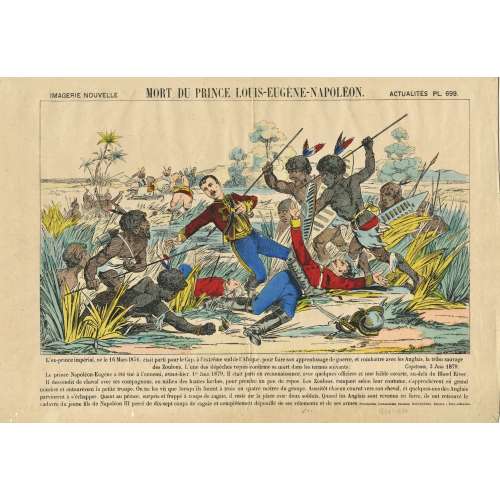 Hand-coloured lithography on wove paper, 275 x 385 mm; vertical centerfold, image in frame. On reverse: black ink stamp “5350”. Above the frame: "IMAGERIE NOUVELLE — MORT DU PRINCE LOUIS-EUGÈNE-NAPOLÉON. — ACTUALITÉS PL. 699". Under the frame: "L'ex-prince impérial, né le 16 Mars I856, était parti pour le Cap, à l'extrême sud de l'Afrique, pour faire son apprentissage de guerre, et combattre avec les Anglais, la tribu sauvage des Zoulous. L'une des dépêches reçues confirme sa mort dans les termes suivants: — Capetown, 3 Juin 1879. — Le prince Napoléon-Eugène a été tué à l'ennemi, avant-hier, 1er Juin 1879, Il était parti en reconnaissance, avec quelques officiers et une fable escorte, au-delà du Blood River. Il descendit de cheval ave ses compagnons, au milieu des hautes herbes, pour prendre un peu de repos. Les Zoulous, rampant selon leur coutume, s'approchèrent en grand nombre et entourèrent la petite troupe. On ne les vit que lorsqu' ils furent à trois ou quatre mètres du groupe. Aussitôt chacun court vers son cheval, et quelques-uns des Anglais parvinrent à s'échapper. Quant au prince, surpris et frappé à coups de zagaie, il resta sur la place avec deux soldats. Quand les Anglais sont revenus en force, ils ont retrouvé le cadavre du jeune fils de Napoléon III percé de dix-sept coups de zagaie et complétement dépouillé de ses vêtements et de ses armes". — "Typographie, Lithographie, Imagerie, Haguenthal, Éditeur à Pont-à-Mousson". Pencil ms: "1860-1880". Élie Haguenthal (French, 1822 – 1881) – publisher/printer.
Hand-coloured lithography on wove paper, 275 x 385 mm; vertical centerfold, image in frame. On reverse: black ink stamp “5350”. Above the frame: "IMAGERIE NOUVELLE — MORT DU PRINCE LOUIS-EUGÈNE-NAPOLÉON. — ACTUALITÉS PL. 699". Under the frame: "L'ex-prince impérial, né le 16 Mars I856, était parti pour le Cap, à l'extrême sud de l'Afrique, pour faire son apprentissage de guerre, et combattre avec les Anglais, la tribu sauvage des Zoulous. L'une des dépêches reçues confirme sa mort dans les termes suivants: — Capetown, 3 Juin 1879. — Le prince Napoléon-Eugène a été tué à l'ennemi, avant-hier, 1er Juin 1879, Il était parti en reconnaissance, avec quelques officiers et une fable escorte, au-delà du Blood River. Il descendit de cheval ave ses compagnons, au milieu des hautes herbes, pour prendre un peu de repos. Les Zoulous, rampant selon leur coutume, s'approchèrent en grand nombre et entourèrent la petite troupe. On ne les vit que lorsqu' ils furent à trois ou quatre mètres du groupe. Aussitôt chacun court vers son cheval, et quelques-uns des Anglais parvinrent à s'échapper. Quant au prince, surpris et frappé à coups de zagaie, il resta sur la place avec deux soldats. Quand les Anglais sont revenus en force, ils ont retrouvé le cadavre du jeune fils de Napoléon III percé de dix-sept coups de zagaie et complétement dépouillé de ses vêtements et de ses armes". — "Typographie, Lithographie, Imagerie, Haguenthal, Éditeur à Pont-à-Mousson". Pencil ms: "1860-1880". Élie Haguenthal (French, 1822 – 1881) – publisher/printer. -
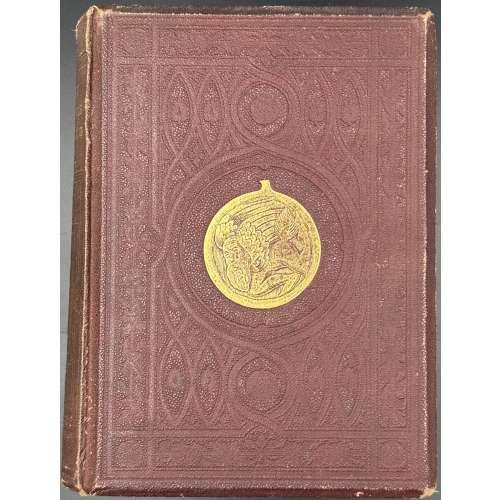 Hardcover, 23 x 17 x 4.7 cm, burgundy buckram, bevelled boards, blind geometrical design with a gilt medallion at the centre, gilt lettering and blind design elements to spine, text in frame, all edges red; pp.: [i-v] vi-xvi, [1] 2-494, [2 advert.], [1] 2-32 advert.], collation 4to: a-b4, B-3R4, a16. Title-page (red and black, in red frame): A HISTORY | OF | CARICATURE & GROTESQUE | {gothic letters} In Literature and Art. | By THOMAS WRIGHT, Esq., M.A., F.S.A., | Hon. M.R.S.L., &c.; | Corresponding Member of the Imperial Institute of France | (Académie des Inscriptions et Belles Lettres). |{double rules} | WITH | ILLUSTRATIONS FROM VARIOUS SOURCES, | DRAWN AND ENGRAVED BY | F. W. FAIRHOLT, Esq., F.S.A. | {double rules} | {gothic letters} London : | VIRTUE BROTHERS & CO., 1, AMEN CORNER, | PATERNOSTER ROW. | 1865. Contributors : Thomas Wright (British, 1792 – 1849) – author. Frederick William Fairholt (British, 1814 – 1866) – artist/engraver. Virtue Brothers & Co. (London) – publisher/printer.
Hardcover, 23 x 17 x 4.7 cm, burgundy buckram, bevelled boards, blind geometrical design with a gilt medallion at the centre, gilt lettering and blind design elements to spine, text in frame, all edges red; pp.: [i-v] vi-xvi, [1] 2-494, [2 advert.], [1] 2-32 advert.], collation 4to: a-b4, B-3R4, a16. Title-page (red and black, in red frame): A HISTORY | OF | CARICATURE & GROTESQUE | {gothic letters} In Literature and Art. | By THOMAS WRIGHT, Esq., M.A., F.S.A., | Hon. M.R.S.L., &c.; | Corresponding Member of the Imperial Institute of France | (Académie des Inscriptions et Belles Lettres). |{double rules} | WITH | ILLUSTRATIONS FROM VARIOUS SOURCES, | DRAWN AND ENGRAVED BY | F. W. FAIRHOLT, Esq., F.S.A. | {double rules} | {gothic letters} London : | VIRTUE BROTHERS & CO., 1, AMEN CORNER, | PATERNOSTER ROW. | 1865. Contributors : Thomas Wright (British, 1792 – 1849) – author. Frederick William Fairholt (British, 1814 – 1866) – artist/engraver. Virtue Brothers & Co. (London) – publisher/printer. -
 Artist: Utagawa Kunisada [歌川 国貞] a.k.a. Utagawa Toyokuni III [三代歌川豊国] (Japanese, 1786 – 1865). Signed: Toyokuni ga [豊国 画] in a red toshidama cartouche. Actor: Ichikawa Danjūrō VII 市川団十郎 (Japanese, 1791 – 1859); other names: Ichikawa Ebizō V, Ichikawa Hakuen II, Ichikawa Shinnosuke I. Character: Tanbaya Onizo [丹波屋鬼蔵] Play: Koi Bikyaku Yamato Orai [恋飛脚大和往来] Performance: Kawarasaki Theatre [河原崎座] in the 2nd month of 1851. Double nanushi censor seals: Fuku & Muramatsu, from 3rd month of Kaei 2 to 11th month of Kaei 4 (1849-51). Another fan print from the pair SVJP-0212-2.2016: Sawamura Chōjūrō V as Kameya Chubei.
Artist: Utagawa Kunisada [歌川 国貞] a.k.a. Utagawa Toyokuni III [三代歌川豊国] (Japanese, 1786 – 1865). Signed: Toyokuni ga [豊国 画] in a red toshidama cartouche. Actor: Ichikawa Danjūrō VII 市川団十郎 (Japanese, 1791 – 1859); other names: Ichikawa Ebizō V, Ichikawa Hakuen II, Ichikawa Shinnosuke I. Character: Tanbaya Onizo [丹波屋鬼蔵] Play: Koi Bikyaku Yamato Orai [恋飛脚大和往来] Performance: Kawarasaki Theatre [河原崎座] in the 2nd month of 1851. Double nanushi censor seals: Fuku & Muramatsu, from 3rd month of Kaei 2 to 11th month of Kaei 4 (1849-51). Another fan print from the pair SVJP-0212-2.2016: Sawamura Chōjūrō V as Kameya Chubei.
-
 Artist: Utagawa Toyokuni I (1769–1825) Actor Matsumoto Kōshirō V plays the role of Ikyû in the drama "Sukeroku Yukari no Edo Zakura". The roles of Sukeroku and the courtesan Agemaki are played by Ichikawa Danjûrô VII and Iwai Hanshirô V". Ichimura Theater in Edo in 2nd lunar month of 1811. Publisher: Chōjiya Kichi (1811-1826); Marks' "Publishers" № 028, p. 103. Size: Vertical ôban Woodblock print (nishiki-e); ink and color on paper. Signed: Toyokuni ga My print is the right sheet of a triptych (see: Rare books exhibition in January 2013).
Artist: Utagawa Toyokuni I (1769–1825) Actor Matsumoto Kōshirō V plays the role of Ikyû in the drama "Sukeroku Yukari no Edo Zakura". The roles of Sukeroku and the courtesan Agemaki are played by Ichikawa Danjûrô VII and Iwai Hanshirô V". Ichimura Theater in Edo in 2nd lunar month of 1811. Publisher: Chōjiya Kichi (1811-1826); Marks' "Publishers" № 028, p. 103. Size: Vertical ôban Woodblock print (nishiki-e); ink and color on paper. Signed: Toyokuni ga My print is the right sheet of a triptych (see: Rare books exhibition in January 2013). A lookalike triptych by Kunisada can be found in Ronin Gallery:
A lookalike triptych by Kunisada can be found in Ronin Gallery:
 Data from Kabuki21:
Stage names:
Matsumoto Kôshirô V, Ichikawa Komazô III, Ichikawa Sumizô I
Guild: Kôraiya
Line number: GODAIME (V)
Poetry names: Kinshô, Kinkô
Existence: 1764 ~ 10th day of the 5th lunar month of 1838
Connection:
Father: Matsumoto Kôshirô IV
Sons: Matsumoto Kôshirô VI, Ichikawa Sumizô II
Disciples: Matsumoto Kojirô, Matsumoto Kingo I, Matsumoto Hidejûrô II
Data from Kabuki21:
Stage names:
Matsumoto Kôshirô V, Ichikawa Komazô III, Ichikawa Sumizô I
Guild: Kôraiya
Line number: GODAIME (V)
Poetry names: Kinshô, Kinkô
Existence: 1764 ~ 10th day of the 5th lunar month of 1838
Connection:
Father: Matsumoto Kôshirô IV
Sons: Matsumoto Kôshirô VI, Ichikawa Sumizô II
Disciples: Matsumoto Kojirô, Matsumoto Kingo I, Matsumoto Hidejûrô II
Matsumoto Kôshirô V was one of the Kabuki giants, a senryô yakusha, during the Bunka, Bunsei and Tenpô eras. In his 20's he was a tachiyaku actor excelling in nimaime roles like Soga Jûrô Sukenari in sogamono dramas. He started to perform jitsuaku roles from the 11th lunar month of 1798 and quickly became one of the best actors for villain roles, especially in Tsuruya Nanboku IV's kizewamono. He had a considerable influence on actors like Onoe Kikugorô III or Ichikawa Danjûrô VII. The kata he deviced for some of the most famous roles in Kabuki history, like Gonta ("Sushiya") or Nikki Danjô* ("Meiboku Sendai Hagi") are still used nowadays. "The fifth Kôshirô had a very large nose and his eyes were close together, two facial defects the print artists were fond of depicting, so that this Edo actor is easily picked out in the pictures illustrating the theatre of this time." (Zoë Kincaid in "Kabuki, the Popular Stage of Japan")
-
 Utagawa Kunisada [歌川 国貞]; a.k.a. Utagawa Toyokuni III [三代歌川豊国] (Japanese, 1786 – 1865). Signed: Toyokuni ga [豊国 画] in a red toshidama cartouche. Publisher: Ibaya Senzaburō [伊場屋仙三郎] (Japanese, fl. 1815 – 1869). Block carver: Yokokawa Takejirō [横川竹二郎] (Japanese, fl. 1845 – 1863), seal: 彫竹 – Hori Take. Date seal and aratame censor seal: May of the Year of Dragon [辰五] (Tatsu-go) (5/1856) (Not in Marks).
Utagawa Kunisada [歌川 国貞]; a.k.a. Utagawa Toyokuni III [三代歌川豊国] (Japanese, 1786 – 1865). Signed: Toyokuni ga [豊国 画] in a red toshidama cartouche. Publisher: Ibaya Senzaburō [伊場屋仙三郎] (Japanese, fl. 1815 – 1869). Block carver: Yokokawa Takejirō [横川竹二郎] (Japanese, fl. 1845 – 1863), seal: 彫竹 – Hori Take. Date seal and aratame censor seal: May of the Year of Dragon [辰五] (Tatsu-go) (5/1856) (Not in Marks). Uncut fan print (uchiwa-e) depicting Onoe Kikugorō IV as Karukaya Dōshin parting from his son, Ishidomaru (played by Ichimura Uzaemon XIII), and Kawarasaki Gonjūrō I as Yamazakiya Yogoro in the kabuki play Karukaya Dōshin Tsukushi no Iezuto [苅萱桑門筑紫𨏍], written by Namiki Sōsuke [並木宗輔] (Japanese, 1695 – 1751) and performed at Ichimuraza [市村座] in 05/1856.
Media: Fan print [団扇絵] (Uchiwa-e); size: 235 x 305 mm.
Actors:
Onoe Kikugorō IV [四代目 尾上菊五郎] (Japanese, 1808 – 1860); other names: Onoe Baikō IV, Onoe Eizaburō III, Onoe Kikue, Nakamura Tatsuzō, Nakamura Kachō.
Onoe Kikugorō V [五代目尾上菊五郎] (Japanese, 1844 – 1903 other names: Onoe Baikō V, Ichimura Kakitsu IV, Ichimura Uzaemon XIII [十三代目市村羽左衛門], Ichimura Kurōemon.
Ichikawa Danjūrō IX [市川団十郎] (Japanese, 1838 – 1903); other names: Kawarasaki Sanshō, Kawarasaki Gonnosuke VII, Kawarasaki Gonjūrō I, Kawarasaki Chōjūrō III.
Plot: It was a popular belief at one time that jealous women had their hair transformed into writhing serpents and Kato Sayemon Shige-Uji, a daimyo of Tsukushi, a much-married man, suffered from the delusion that his wife was so affected. He fled to the mountains to escape her and led the life of a hermit under the name of Karukaya Doshin [苅萓道心]. One day, on Mount Kōya (高野山, Kōyasan) Karukaya meets a young man who was wandering in the mountains. Being questioned, the youth tells his name, Ishidomaru, and elicits the information that he is seeking his lost father. Karukaya then recognizes the boy as his own son, but firm in the resolve to remain lost to the world, he refrains from disclosing himself, and bids the youth return home.
Provenance: Paul F. Walter (American, 1935 – 2017).
Ref.:
Uncut fan print (uchiwa-e) depicting Onoe Kikugorō IV as Karukaya Dōshin parting from his son, Ishidomaru (played by Ichimura Uzaemon XIII), and Kawarasaki Gonjūrō I as Yamazakiya Yogoro in the kabuki play Karukaya Dōshin Tsukushi no Iezuto [苅萱桑門筑紫𨏍], written by Namiki Sōsuke [並木宗輔] (Japanese, 1695 – 1751) and performed at Ichimuraza [市村座] in 05/1856.
Media: Fan print [団扇絵] (Uchiwa-e); size: 235 x 305 mm.
Actors:
Onoe Kikugorō IV [四代目 尾上菊五郎] (Japanese, 1808 – 1860); other names: Onoe Baikō IV, Onoe Eizaburō III, Onoe Kikue, Nakamura Tatsuzō, Nakamura Kachō.
Onoe Kikugorō V [五代目尾上菊五郎] (Japanese, 1844 – 1903 other names: Onoe Baikō V, Ichimura Kakitsu IV, Ichimura Uzaemon XIII [十三代目市村羽左衛門], Ichimura Kurōemon.
Ichikawa Danjūrō IX [市川団十郎] (Japanese, 1838 – 1903); other names: Kawarasaki Sanshō, Kawarasaki Gonnosuke VII, Kawarasaki Gonjūrō I, Kawarasaki Chōjūrō III.
Plot: It was a popular belief at one time that jealous women had their hair transformed into writhing serpents and Kato Sayemon Shige-Uji, a daimyo of Tsukushi, a much-married man, suffered from the delusion that his wife was so affected. He fled to the mountains to escape her and led the life of a hermit under the name of Karukaya Doshin [苅萓道心]. One day, on Mount Kōya (高野山, Kōyasan) Karukaya meets a young man who was wandering in the mountains. Being questioned, the youth tells his name, Ishidomaru, and elicits the information that he is seeking his lost father. Karukaya then recognizes the boy as his own son, but firm in the resolve to remain lost to the world, he refrains from disclosing himself, and bids the youth return home.
Provenance: Paul F. Walter (American, 1935 – 2017).
Ref.:
- [LIB-2110.2019] Samuel L. Leiter. Historical Dictionary of Japanese Traditional Theatre (Historical Dictionaries of Literature and the Arts). / 2nd edition. – Lanham: Rowman & Littlefield, 2014; pp. 379-380.
- [LIB-2206.2019] Basil Stewart. Subjects portrayed in Japanese colour-prints. — London: Kegan Paul, Trench, Trubner & Co. Ltd., 1922.
-
 Artist: Utagawa Kunisada [歌川 国貞] a.k.a. Utagawa Toyokuni III [三代 歌川 豊国] (Japanese, 1786 – 1865). Signed: Kōchōrō Kunisada ga [香蝶楼国貞画] in a double-gourd cartouche. Iseya Sōemon [伊勢屋惣右衛門] (Japanese, 1776 – 1862); seal: Ue [上] (Marks 02-041 | 156a). Inscription in the red stripe: Five types of haiku in shōfū style [俳諧五流蕉風] (Haikai gōryū shōfū). Censor's seal: Watari [渡] (Watanabe Shōemon), VI/1842–V ic/1846. Media: Fan print [団扇絵] (Uchiwa-e); size: 225 x 292 mm. An uncut fan print depicts a young woman with an insect (firefly) cage in her left hand. Her striped kimono is adorned with the design of white, grey and blue cherry blossoms. Two of the Seven Grasses of Autumn [秋の七草] (aki no nanakusa), namely Platycodon grandiflorus (kikyō) [桔梗] a.k.a. Chinese bellflower (or balloon flower) and Patrinia scabiosifolia (ominaeshi) [女郎花] a. k.a. Eastern (or Golden) Valerian, are seen on her right-hand side.
Artist: Utagawa Kunisada [歌川 国貞] a.k.a. Utagawa Toyokuni III [三代 歌川 豊国] (Japanese, 1786 – 1865). Signed: Kōchōrō Kunisada ga [香蝶楼国貞画] in a double-gourd cartouche. Iseya Sōemon [伊勢屋惣右衛門] (Japanese, 1776 – 1862); seal: Ue [上] (Marks 02-041 | 156a). Inscription in the red stripe: Five types of haiku in shōfū style [俳諧五流蕉風] (Haikai gōryū shōfū). Censor's seal: Watari [渡] (Watanabe Shōemon), VI/1842–V ic/1846. Media: Fan print [団扇絵] (Uchiwa-e); size: 225 x 292 mm. An uncut fan print depicts a young woman with an insect (firefly) cage in her left hand. Her striped kimono is adorned with the design of white, grey and blue cherry blossoms. Two of the Seven Grasses of Autumn [秋の七草] (aki no nanakusa), namely Platycodon grandiflorus (kikyō) [桔梗] a.k.a. Chinese bellflower (or balloon flower) and Patrinia scabiosifolia (ominaeshi) [女郎花] a. k.a. Eastern (or Golden) Valerian, are seen on her right-hand side. -
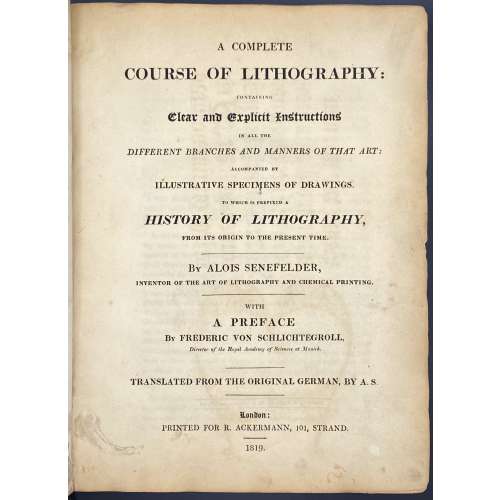 Title: A COMPLETE | COURSE OF LITHOGRAPHY: | CONTAINING | Clear and Explicit Instructions | IN ALL THE | DIFFERENT BRANCHES AND MANNERS OF THAT ART | ACCOMPANIED BY | ILLUSTRATIVE SPECIMENS OF DRAWINGS. | TO WHICH IS PREFIXED A | HISTORY OF LITHOGRAPHY, | FROM ITS ORIGIN TO THE PRESENT TIME. | By ALOIS SENEFELDER, | INVENTOR OF THE ART OF LITHOGRAPHY AND CHEMICAL PRINTING. | WITH | A PREFACE | By FREDERIC VON SCHLICHTEGROLL, |Director of the Royal Academy of Sciences at Munich. | TRANSLATED FROM THE ORIGINAL GERMAN, BY A.S. | London: | PRINTED FOR R. ACKERMANN, 101 STRAND. | 1819. || Pagination: [i-iii] iv-xxviii, [4] [1] 2-342. Collation: 4to; [a]-d4, B-2U4 2X2, +14 lithographed plates by Ackermann (incl. 1 folding, 1 colour frontispiece and 1 portrait of A. Senefelder); plates opposite to pp. [i], [1], 193, 198, 203, 228, 232 (fold.), 256, 258, 264, 269, 290, 302, and 305. Binding: By Anne Krawitz (Philadelphia, PA), 27.5 x 21 cm, modern full mottled calf, boards ruled in gilt, flat spine, compartments ruled in gilt, crimson label with gilt lettering to spine, printed on wove paper; round book-plate to front paste-down “TWM, The Whitehead Library”. Edition: 1st in English. Ref.: MET: Accession Number: Ref.20; RCT: RCIN 1195886; Contributors: Alois Senefelder (German, 1771 – 1834) – author of the original and translator. Friedrich Schlichtegroll (German, 1765 – 1822) – author of preface. William Clowes (British, 1779 – 1847) – printer. Rudolph Ackermann (German-British, 1764 – 1834) – publisher and lithographer. Samuel Prout (British, 1783 – 1852) Maximilian Joseph, King of Bavaria (German, 1756 –1825) – dedicatee.
Title: A COMPLETE | COURSE OF LITHOGRAPHY: | CONTAINING | Clear and Explicit Instructions | IN ALL THE | DIFFERENT BRANCHES AND MANNERS OF THAT ART | ACCOMPANIED BY | ILLUSTRATIVE SPECIMENS OF DRAWINGS. | TO WHICH IS PREFIXED A | HISTORY OF LITHOGRAPHY, | FROM ITS ORIGIN TO THE PRESENT TIME. | By ALOIS SENEFELDER, | INVENTOR OF THE ART OF LITHOGRAPHY AND CHEMICAL PRINTING. | WITH | A PREFACE | By FREDERIC VON SCHLICHTEGROLL, |Director of the Royal Academy of Sciences at Munich. | TRANSLATED FROM THE ORIGINAL GERMAN, BY A.S. | London: | PRINTED FOR R. ACKERMANN, 101 STRAND. | 1819. || Pagination: [i-iii] iv-xxviii, [4] [1] 2-342. Collation: 4to; [a]-d4, B-2U4 2X2, +14 lithographed plates by Ackermann (incl. 1 folding, 1 colour frontispiece and 1 portrait of A. Senefelder); plates opposite to pp. [i], [1], 193, 198, 203, 228, 232 (fold.), 256, 258, 264, 269, 290, 302, and 305. Binding: By Anne Krawitz (Philadelphia, PA), 27.5 x 21 cm, modern full mottled calf, boards ruled in gilt, flat spine, compartments ruled in gilt, crimson label with gilt lettering to spine, printed on wove paper; round book-plate to front paste-down “TWM, The Whitehead Library”. Edition: 1st in English. Ref.: MET: Accession Number: Ref.20; RCT: RCIN 1195886; Contributors: Alois Senefelder (German, 1771 – 1834) – author of the original and translator. Friedrich Schlichtegroll (German, 1765 – 1822) – author of preface. William Clowes (British, 1779 – 1847) – printer. Rudolph Ackermann (German-British, 1764 – 1834) – publisher and lithographer. Samuel Prout (British, 1783 – 1852) Maximilian Joseph, King of Bavaria (German, 1756 –1825) – dedicatee. -
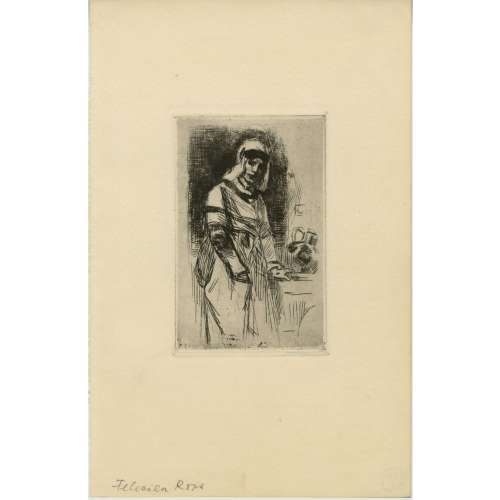
A woman from Antwerp or a servant, another title "Laitière anversoise"; 2nd state. Etching on wove paper. Owner's stamp LVM on verso.
Dimensions: Paper: 24.4 x 15.8 cm; Image: 12 x 7.5 cm
Catalogue raisonné: Arthur Hubschmid (1977): 343.
-
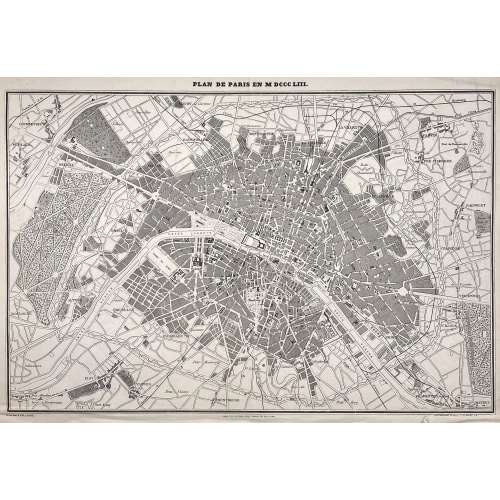 Above the frame: PLAN DE PARIS EN MDCCCLIII. Below the frame: Gravé par F. DELAMARE […] PARIS. TYP. DE FIRMIN DIDOT FRÈRES, 56, RUE JACOB. […] PANICONOGRAPHIE DE GILLOT. Q. ST. MICHEL 23. Dimensions: Sheet: 37 x 52.5 cm: Image: 33 x 50 cm. Technique: Photozincography Contributors: Ferdinand Théodore Delamare (French, fl. 1850 – 1889) – engraver. Firmin Didot Frères ; Firmin Didot (French, 1764 – 1836) – publisher. Firmin Gillot (French, 1819 – 1872) – printer.
Above the frame: PLAN DE PARIS EN MDCCCLIII. Below the frame: Gravé par F. DELAMARE […] PARIS. TYP. DE FIRMIN DIDOT FRÈRES, 56, RUE JACOB. […] PANICONOGRAPHIE DE GILLOT. Q. ST. MICHEL 23. Dimensions: Sheet: 37 x 52.5 cm: Image: 33 x 50 cm. Technique: Photozincography Contributors: Ferdinand Théodore Delamare (French, fl. 1850 – 1889) – engraver. Firmin Didot Frères ; Firmin Didot (French, 1764 – 1836) – publisher. Firmin Gillot (French, 1819 – 1872) – printer. -
 Artist: Utagawa Kunisada [歌川 国貞] a.k.a. Utagawa Toyokuni III [三代歌川豊国] (Japanese, 1786 – 1865). Block cutter: Yokokawa Takejirō [横川竹二郎] (Japanese, fl. 1845 – 1863), seal Hori Take [彫竹]. Publisher: Ibaya Senzaburō [伊場屋仙三郎] (Japanese, fl. C. 1845 – 1847). Title: Book of an incoming ship [入船帳] (Irifune-chō). Series: Comparison of Eight Books of Proficiency and Eloquence [口も手も美立八帳] (Kuchimo temo mitate hatchō). Date seal and aratame censor seal: 1856 (Ansei 3). Signed: Toyokuni ga in toshidama cartouche. Media: Untrimmed fan print (uchiwa-e), 231 x 300 mm. Provenance: The Collection of Paul F. Walter, Christie's, New York, 2017, lot 341; sold together with 5 other fan prints for $25,000. Before: Israel Goldman, Japanese Prints, Catalogue 11, 2005, no. 37. Ref: [LIB-1693.2018] The Collection of Paul Walter. — NY: Christie's, 2017, p. 363. Ref: Israel Goldman, Catalogue 2018, № 51: "Utagawa Kunisada (1786-1865) A Beauty Seated in a Boat. From the series Mitate hatcho (A Parody of Eight Books). 1856. Fan print. 23.3 x 30 cm. Provenance: Israel Goldman, Japanese Prints, Catalogue 11, 2005, no. 37, The Collection of Paul F. Walter, Christie's, New York, 2017, lot 341. Fine impression, colour and condition. The title contains the saying: “Kuchi mo hatcho te mo hatcho (As quick with one’s hand as one’s tongue)." Special thanks to Horst Graebner for the detailed description.
Artist: Utagawa Kunisada [歌川 国貞] a.k.a. Utagawa Toyokuni III [三代歌川豊国] (Japanese, 1786 – 1865). Block cutter: Yokokawa Takejirō [横川竹二郎] (Japanese, fl. 1845 – 1863), seal Hori Take [彫竹]. Publisher: Ibaya Senzaburō [伊場屋仙三郎] (Japanese, fl. C. 1845 – 1847). Title: Book of an incoming ship [入船帳] (Irifune-chō). Series: Comparison of Eight Books of Proficiency and Eloquence [口も手も美立八帳] (Kuchimo temo mitate hatchō). Date seal and aratame censor seal: 1856 (Ansei 3). Signed: Toyokuni ga in toshidama cartouche. Media: Untrimmed fan print (uchiwa-e), 231 x 300 mm. Provenance: The Collection of Paul F. Walter, Christie's, New York, 2017, lot 341; sold together with 5 other fan prints for $25,000. Before: Israel Goldman, Japanese Prints, Catalogue 11, 2005, no. 37. Ref: [LIB-1693.2018] The Collection of Paul Walter. — NY: Christie's, 2017, p. 363. Ref: Israel Goldman, Catalogue 2018, № 51: "Utagawa Kunisada (1786-1865) A Beauty Seated in a Boat. From the series Mitate hatcho (A Parody of Eight Books). 1856. Fan print. 23.3 x 30 cm. Provenance: Israel Goldman, Japanese Prints, Catalogue 11, 2005, no. 37, The Collection of Paul F. Walter, Christie's, New York, 2017, lot 341. Fine impression, colour and condition. The title contains the saying: “Kuchi mo hatcho te mo hatcho (As quick with one’s hand as one’s tongue)." Special thanks to Horst Graebner for the detailed description. -
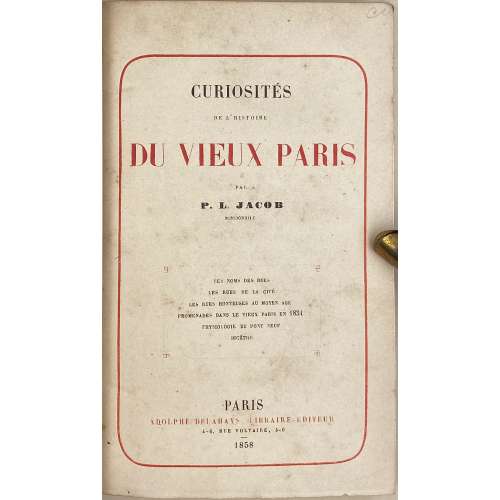 Title-page: CURIOSITÉS | DE L’HISTOIRE | DU VIEUX PARIS | PAR | P. L. JACOB | BIBLIOPHILE | { LES NOMS DES RUES | LES RUES DE CITÉ | LES RUES HONTEUSES AU MOYEN AGE. | PROMENADES DANS LE VIEUX PARIS EN 1834. | PHYSIOLOGIE DU PONT NEUF. | BICÊTRE } | PARIS | ADOLPHE DELAHAYS, LIBRAIRE-ÉDITEUR | 4-6, RUE VOLTAIRE, 4-6 | – | 1858 || Description: Hardcover, in-16o, 17 x 11 cm, quarter brown morocco over marbled boards, spine with raised bands, gilt lettering, gilt fleurons, marbled endpapers, original wrappers with red and black lettering within red frame bound in, some pages uncut. Collation: 8vo; π2 14, 2-238 244, total 186 leaves between original wrappers. Pagination: [4] [1] 2-364 [4], total 372 pages. Catalogue raisonné: Vicar: I, 770. Contributors: Printer: Simon Raçon et Comp. (Paris). Author: Paul Lacroix [P. L. Jacob] (French, 1806 – 1884). Publisher: Adolphe Delahays (French, mid-19th century).
Title-page: CURIOSITÉS | DE L’HISTOIRE | DU VIEUX PARIS | PAR | P. L. JACOB | BIBLIOPHILE | { LES NOMS DES RUES | LES RUES DE CITÉ | LES RUES HONTEUSES AU MOYEN AGE. | PROMENADES DANS LE VIEUX PARIS EN 1834. | PHYSIOLOGIE DU PONT NEUF. | BICÊTRE } | PARIS | ADOLPHE DELAHAYS, LIBRAIRE-ÉDITEUR | 4-6, RUE VOLTAIRE, 4-6 | – | 1858 || Description: Hardcover, in-16o, 17 x 11 cm, quarter brown morocco over marbled boards, spine with raised bands, gilt lettering, gilt fleurons, marbled endpapers, original wrappers with red and black lettering within red frame bound in, some pages uncut. Collation: 8vo; π2 14, 2-238 244, total 186 leaves between original wrappers. Pagination: [4] [1] 2-364 [4], total 372 pages. Catalogue raisonné: Vicar: I, 770. Contributors: Printer: Simon Raçon et Comp. (Paris). Author: Paul Lacroix [P. L. Jacob] (French, 1806 – 1884). Publisher: Adolphe Delahays (French, mid-19th century). -
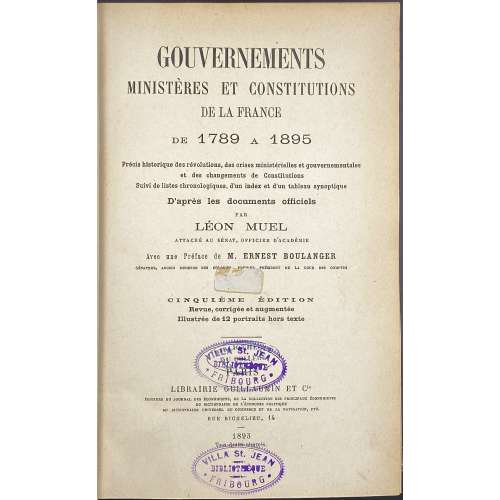 Title-page: GOUVERNEMENTS | MINISTÈRES ET CONSTITUTIONS | DE LA FRANCE | DE 1789 A 1895 | Précis historique des révolutions, des crises ministérielles et gouvernementales | et des changements de Constitutions | Suivi de listes chronologiques, d’un index et d’un tableau synoptique | D’après les documents officiels | PAR | LÉON MUEL | ATTACHÉ AU SÉNAT, OFFICIER D’ACADÉMIE | Avec une Préface de M. ERNEST BOULANGER | SÉNATEUR, ANCIEN MINISTRE DES COLONIES, PREMIER PRÉSIDENT DE LA COUR DES COMPTES | CINQUIÈME ÉDITION | Revue, corrigée et augmentée | Illustrée de 12 portraits hors texte | — | PARIS | LIBRAIRIE GUILLAUMIN ET Cie | ÉDITEURS DU JOURNAL DES ÉCONOMISTES, DE LA COLLECTION DES PRINCIPAUX ÉCONOMISTES | DU DICTIONNAIRE DE L’ÉCONOMIE POLITIQUE | DU DICTIONNAIRE UNIVERSEL DU COMMERCE ET DE LA NAVIGATION, ETC. | RUE RICHELIEU, 14 | 1895 | Tous droits réservés. || Binding: Hardcover, 22.1 x 16.6 cm x 5.0 cm, 8vo, quarter brown morocco over marbled boards, raised bands with gilt fillets and black label with gilt lettering to spine, marbled endpapers. Library stamps to t.p. and inside in blue ink: “VILLA St. JEAN | BIBLIOTHÈQUE | * FRIBOURG *”. Villa St. Jean International School, originally named Collège Villa St. Jean, was a private Catholic school in Fribourg, Switzerland, from 1903 to 1970 (see Wikipedia). Collation: ffl, π4, [1] 2-348, χ6, Suppl.: [1] 2-98, χ2, ffl; total within the flyleaves 282+76 leaves, some uncut; plus twelve plates (photographs) with tissue guards and two folding tables. Pagination: [i-v] vi-x, [2] [1] 2-4, (lacks 4: 5-8) [9] 10-535 [536] (lacks 2: 537, 538) [539] 540-557 [558 blank]; Supplément [1] 2-144, [145-6 table alphabét./blank], [147-8 table des matières/blank]; total within the flyleaves 564+148 pages, ils., plates. Provenance: Library of Villa St. Jean, Fribourg, Switzerland. Contributors: Muel, Léon (French, 1850 – 19..?) – author. Boulanger, Ernest-Théophile (French, 1831 – 1907) – author of preface. Librairie de Guillaumin et Cie – publisher. Table of contents:AVANT-PROPOSLETTRE-PRÉFACEPREMIÈRE PARTIEI. – MONARCHIE FRANÇAISE – BOURBONSLouis XVI, roi de France et de Navarre (10 MAI 1774 – 21 SEPTEMBRE 1792)II. – RÉPUBLIQUE FRANÇAISE (21 SEPTEMBRE 1792 – 18 MAI 1804)Convention nationale (20 SEPTEMBRE 1792 – 26 OCTOBRE 1795)Directoire exécutif (2 NOVEMBRE 1795 – 10 NOVEMBRE 1799)Consulat (19 BRUMAIRE AN VIII – 28 FLORÉAL AN XII) (10 NOVEMBRE 1799-18 MAI 1804);III. – EMPIRE FRANÇAIS (18 MAI 1804 – 31 MARS 1814)Napoléon Ier, Empereur des Français (18 MAI 1804 – 31 MARS 1814)Gouvernement provisoire (1er 14 AVRIL 1814)IV. – RESTAURATION – BOURBONS (14 AVRIL 1814 – 29 JUILLET 1830)Lieutenance générale du Royaume (14 AVRIL – 2 MAI 1814)Louis XVIII, roi de France et de Navarre (2 MAI 1814 – 20 MARS 1815)Cent Jours (20 MARS – 22 JUIN 1815)Commission de Gouvernement (22 JUIN – 7 JUILLET 1815)Louis XVIII, roi de France et de Navarre (8 JUILLET 1815 – 16 SEPTEMBRE 1824)Charles X, roi de France et de Navarre (16 SEPTEMBRE 1824 – 29 JUILLET 1830)Révolution de 1830Chute de Charles X et du ministère Polignac (29 JUILLET 1830). Gouvernement provisoire (29 – 31 JUILLET 1830)V. – MONARCHIE CONSTITUTIONNELLE – BRANCHE D'ORLÉANS (31 JUILLET 1830 – 24 FÉVRIER 1848)Lieutenance générale du Royaume (31 JUILLET – 9 AOUT 1830)Louis-Philippe Ier, roi des Français (9 AOUT 1830 – 24 FÉVRIER 1848)Révolution de 1848Chute du ministère Guizot (23 février) et du roi Louis-Philippe (24 février 1848)VI. – DEUXIÈME RÉPUBLIQUE FRANÇAISE (24 FÉVRIER 1848 – 2 DÉCEMBRE 1852)Gouvernement provisoire (24 FÉVRIER – 9 MAI 1848)Assemblée Nationale Constituante (4 MAI 1848 – 26 MAI 1849)Commission exécutive (9 MAI – 24 JUIN 1848)Le général Cavaignac chef du Pouvoir exécutif Président du Conseil des Ministres (28 JUIN – 20 DÉCEMBRE 1848)Louis-Napoléon Bonaparte Président de la République Française (20 DÉCEMBRE 1848 – 2 DÉCEMBRE 1852)VII. – SECOND EMPIRE FRANÇAIS (2 DÉCEMBRE 1852 – 4 SEPTEMBRE 1870)Napoléon III, empereur des Français (2 DÉCEMBRE 1852 – 4 SEPTEMBRE 1870)Révolution du 4 septembre 1870 Chute du second Empire et du ministère PalikaoVIII. – TROISIÈME RÉPUBLIQUE FRANÇAISE (4 SEPTEMBRE 1870)Gouvernement de la Défense nationale (4 SEPTEMBRE 1870 – 17 FÉVRIER 1871)Assemblée Nationale Constituante (13 FÉVRIER 1871 – 8 MARS 1876)M. Thiers Chef du Pouvoir exécutif (17 FÉVRIER – 31 AOUT 1871)M. Thiers Président de la République Française (31 AOUT 1871 – 24 MAI 1873)M. le Maréchal de Mac-Mahon, duc de Magenta Président de la République Française (24 MAI 1873 – 30 JANVIER 1879)M. Jules Grévy Président de la République Française (30 JANVIER 1879 – 2 DÉCEMBRE 1887)M. Carnot Président de la République française (3 DÉCEMBRE 1887 – 25 JUIN 1894)SECONDE PARTIE.Listes chronologiques, par ministère, de tous les ministres, depuis le 5 mai 1789 jusqu'en 1890
Title-page: GOUVERNEMENTS | MINISTÈRES ET CONSTITUTIONS | DE LA FRANCE | DE 1789 A 1895 | Précis historique des révolutions, des crises ministérielles et gouvernementales | et des changements de Constitutions | Suivi de listes chronologiques, d’un index et d’un tableau synoptique | D’après les documents officiels | PAR | LÉON MUEL | ATTACHÉ AU SÉNAT, OFFICIER D’ACADÉMIE | Avec une Préface de M. ERNEST BOULANGER | SÉNATEUR, ANCIEN MINISTRE DES COLONIES, PREMIER PRÉSIDENT DE LA COUR DES COMPTES | CINQUIÈME ÉDITION | Revue, corrigée et augmentée | Illustrée de 12 portraits hors texte | — | PARIS | LIBRAIRIE GUILLAUMIN ET Cie | ÉDITEURS DU JOURNAL DES ÉCONOMISTES, DE LA COLLECTION DES PRINCIPAUX ÉCONOMISTES | DU DICTIONNAIRE DE L’ÉCONOMIE POLITIQUE | DU DICTIONNAIRE UNIVERSEL DU COMMERCE ET DE LA NAVIGATION, ETC. | RUE RICHELIEU, 14 | 1895 | Tous droits réservés. || Binding: Hardcover, 22.1 x 16.6 cm x 5.0 cm, 8vo, quarter brown morocco over marbled boards, raised bands with gilt fillets and black label with gilt lettering to spine, marbled endpapers. Library stamps to t.p. and inside in blue ink: “VILLA St. JEAN | BIBLIOTHÈQUE | * FRIBOURG *”. Villa St. Jean International School, originally named Collège Villa St. Jean, was a private Catholic school in Fribourg, Switzerland, from 1903 to 1970 (see Wikipedia). Collation: ffl, π4, [1] 2-348, χ6, Suppl.: [1] 2-98, χ2, ffl; total within the flyleaves 282+76 leaves, some uncut; plus twelve plates (photographs) with tissue guards and two folding tables. Pagination: [i-v] vi-x, [2] [1] 2-4, (lacks 4: 5-8) [9] 10-535 [536] (lacks 2: 537, 538) [539] 540-557 [558 blank]; Supplément [1] 2-144, [145-6 table alphabét./blank], [147-8 table des matières/blank]; total within the flyleaves 564+148 pages, ils., plates. Provenance: Library of Villa St. Jean, Fribourg, Switzerland. Contributors: Muel, Léon (French, 1850 – 19..?) – author. Boulanger, Ernest-Théophile (French, 1831 – 1907) – author of preface. Librairie de Guillaumin et Cie – publisher. Table of contents:AVANT-PROPOSLETTRE-PRÉFACEPREMIÈRE PARTIEI. – MONARCHIE FRANÇAISE – BOURBONSLouis XVI, roi de France et de Navarre (10 MAI 1774 – 21 SEPTEMBRE 1792)II. – RÉPUBLIQUE FRANÇAISE (21 SEPTEMBRE 1792 – 18 MAI 1804)Convention nationale (20 SEPTEMBRE 1792 – 26 OCTOBRE 1795)Directoire exécutif (2 NOVEMBRE 1795 – 10 NOVEMBRE 1799)Consulat (19 BRUMAIRE AN VIII – 28 FLORÉAL AN XII) (10 NOVEMBRE 1799-18 MAI 1804);III. – EMPIRE FRANÇAIS (18 MAI 1804 – 31 MARS 1814)Napoléon Ier, Empereur des Français (18 MAI 1804 – 31 MARS 1814)Gouvernement provisoire (1er 14 AVRIL 1814)IV. – RESTAURATION – BOURBONS (14 AVRIL 1814 – 29 JUILLET 1830)Lieutenance générale du Royaume (14 AVRIL – 2 MAI 1814)Louis XVIII, roi de France et de Navarre (2 MAI 1814 – 20 MARS 1815)Cent Jours (20 MARS – 22 JUIN 1815)Commission de Gouvernement (22 JUIN – 7 JUILLET 1815)Louis XVIII, roi de France et de Navarre (8 JUILLET 1815 – 16 SEPTEMBRE 1824)Charles X, roi de France et de Navarre (16 SEPTEMBRE 1824 – 29 JUILLET 1830)Révolution de 1830Chute de Charles X et du ministère Polignac (29 JUILLET 1830). Gouvernement provisoire (29 – 31 JUILLET 1830)V. – MONARCHIE CONSTITUTIONNELLE – BRANCHE D'ORLÉANS (31 JUILLET 1830 – 24 FÉVRIER 1848)Lieutenance générale du Royaume (31 JUILLET – 9 AOUT 1830)Louis-Philippe Ier, roi des Français (9 AOUT 1830 – 24 FÉVRIER 1848)Révolution de 1848Chute du ministère Guizot (23 février) et du roi Louis-Philippe (24 février 1848)VI. – DEUXIÈME RÉPUBLIQUE FRANÇAISE (24 FÉVRIER 1848 – 2 DÉCEMBRE 1852)Gouvernement provisoire (24 FÉVRIER – 9 MAI 1848)Assemblée Nationale Constituante (4 MAI 1848 – 26 MAI 1849)Commission exécutive (9 MAI – 24 JUIN 1848)Le général Cavaignac chef du Pouvoir exécutif Président du Conseil des Ministres (28 JUIN – 20 DÉCEMBRE 1848)Louis-Napoléon Bonaparte Président de la République Française (20 DÉCEMBRE 1848 – 2 DÉCEMBRE 1852)VII. – SECOND EMPIRE FRANÇAIS (2 DÉCEMBRE 1852 – 4 SEPTEMBRE 1870)Napoléon III, empereur des Français (2 DÉCEMBRE 1852 – 4 SEPTEMBRE 1870)Révolution du 4 septembre 1870 Chute du second Empire et du ministère PalikaoVIII. – TROISIÈME RÉPUBLIQUE FRANÇAISE (4 SEPTEMBRE 1870)Gouvernement de la Défense nationale (4 SEPTEMBRE 1870 – 17 FÉVRIER 1871)Assemblée Nationale Constituante (13 FÉVRIER 1871 – 8 MARS 1876)M. Thiers Chef du Pouvoir exécutif (17 FÉVRIER – 31 AOUT 1871)M. Thiers Président de la République Française (31 AOUT 1871 – 24 MAI 1873)M. le Maréchal de Mac-Mahon, duc de Magenta Président de la République Française (24 MAI 1873 – 30 JANVIER 1879)M. Jules Grévy Président de la République Française (30 JANVIER 1879 – 2 DÉCEMBRE 1887)M. Carnot Président de la République française (3 DÉCEMBRE 1887 – 25 JUIN 1894)SECONDE PARTIE.Listes chronologiques, par ministère, de tous les ministres, depuis le 5 mai 1789 jusqu'en 1890 -
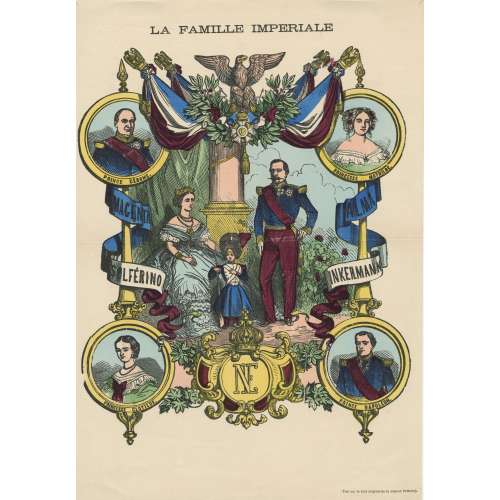 Hand-coloured woodcut on laid paper, 422 x 294 mm; black ink stamp “5307” to reverse, centrefold. Top center: "LA FAMILLE IMPERIALE"; Bottom right: "(Tire sur le bois original de maison Pellerin)". Image: Napoléon III, Empress Eugenie, and Prince Imperial Louis-Napoléon as a child surrounded with four lettered medallions: “PRINCE GÉROME”, “PRINCESSE MATHILDE”, “PRINCESSE CLOTILDE”, and “PRINCE NAPOLÉON”; ribbons lettered: “MAGENTA”, SOLFERINO”, “ALMA”, and “INKERMANN” around heraldic spears; coat of arms with imperial monogram between Princesse Clotilde and Prince Napoléon. Publisher/printer: Jean Charles Pellerin (French, 1756 – 1836). Battle of Magenta : 4 June 1859, against the Austrians. Battle of Solferino : 24 June 1859, against the Austrians. Battle of the Alma : 20 September 1854 (Crimean War) Battle of Inkerman : 5 November 1854 (Crimean War) Characters: Napoleon III [Charles-Louis Napoléon Bonaparte] (French, 1808 – 1873) Eugénie de Montijo [L'impératrice Eugénie] (Spanish-French, 1826 – 1920) Napoléon, Prince Imperial (Napoléon Eugène Louis Jean Joseph Bonaparte] (French, 1856 – 1879) Napoléon-Jérôme Bonaparte [Prince Jérôme] (French, 1822 – 1891) Mathilde Bonaparte [Princess Mathilde] (French, 1820 – 1904) Marie-Clotilde de Savoie [Princesse Clotilde] (French, 1843 – 1911)
Hand-coloured woodcut on laid paper, 422 x 294 mm; black ink stamp “5307” to reverse, centrefold. Top center: "LA FAMILLE IMPERIALE"; Bottom right: "(Tire sur le bois original de maison Pellerin)". Image: Napoléon III, Empress Eugenie, and Prince Imperial Louis-Napoléon as a child surrounded with four lettered medallions: “PRINCE GÉROME”, “PRINCESSE MATHILDE”, “PRINCESSE CLOTILDE”, and “PRINCE NAPOLÉON”; ribbons lettered: “MAGENTA”, SOLFERINO”, “ALMA”, and “INKERMANN” around heraldic spears; coat of arms with imperial monogram between Princesse Clotilde and Prince Napoléon. Publisher/printer: Jean Charles Pellerin (French, 1756 – 1836). Battle of Magenta : 4 June 1859, against the Austrians. Battle of Solferino : 24 June 1859, against the Austrians. Battle of the Alma : 20 September 1854 (Crimean War) Battle of Inkerman : 5 November 1854 (Crimean War) Characters: Napoleon III [Charles-Louis Napoléon Bonaparte] (French, 1808 – 1873) Eugénie de Montijo [L'impératrice Eugénie] (Spanish-French, 1826 – 1920) Napoléon, Prince Imperial (Napoléon Eugène Louis Jean Joseph Bonaparte] (French, 1856 – 1879) Napoléon-Jérôme Bonaparte [Prince Jérôme] (French, 1822 – 1891) Mathilde Bonaparte [Princess Mathilde] (French, 1820 – 1904) Marie-Clotilde de Savoie [Princesse Clotilde] (French, 1843 – 1911) -
 Kitagawa Utamaro (喜多川 歌麿; c. 1753 – 31 October 1806). Act III (Sandanme), from the series The Storehouse of Loyal Retainers (Chûshingura). Publisher Nishimuraya Yohachi (Eijudô). About 1801–02 (Kyôwa 1–2) Vertical ôban; 39.3 x 26 cm (15 1/2 x 10 1/4 in.). Reference: MFA ACCESSION NUMBER 11.14441 Ukiyo-e shûka 3 (1978), list #368.3; Shibui, Ukiyo-e zuten Utamaro (1964), 165.1.3; the series: Asano and Clark 1995, #s 383-5.
Kitagawa Utamaro (喜多川 歌麿; c. 1753 – 31 October 1806). Act III (Sandanme), from the series The Storehouse of Loyal Retainers (Chûshingura). Publisher Nishimuraya Yohachi (Eijudô). About 1801–02 (Kyôwa 1–2) Vertical ôban; 39.3 x 26 cm (15 1/2 x 10 1/4 in.). Reference: MFA ACCESSION NUMBER 11.14441 Ukiyo-e shûka 3 (1978), list #368.3; Shibui, Ukiyo-e zuten Utamaro (1964), 165.1.3; the series: Asano and Clark 1995, #s 383-5. -

Iron tsuba of mokko form with rough surface decorated in low relief carving (sukidashi-bori) and openwork (sukashi) with a flying bat, a crescent moon, and a cloud over the moon. Bat's eyes inlaid with gold. Crescent moon and cloud on the reverse. Copper sekigane. Kogai hitsu-ana plugged with shakudō.
Unsigned.
Edo period.Size: Height: 83.7 mm; Width: 80.3 mm; Thickness: 2.9 mm; Weight: 141 g.





